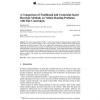Free Online Productivity Tools
i2Speak
i2Symbol
i2OCR
iTex2Img
iWeb2Print
iWeb2Shot
i2Type
iPdf2Split
iPdf2Merge
i2Bopomofo
i2Arabic
i2Style
i2Image
i2PDF
iLatex2Rtf
Sci2ools
CONSTRAINTS
2000
2000
A Comparison of Traditional and Constraint-based Heuristic Methods on Vehicle Routing Problems with Side Constraints
The vehicle routing problem (VRP) is a variant of the familiar travelling salesperson problem (TSP). In the VRP we are to perform a number of visits, using a number of vehicles of limited capacity, while typically minimizing the distance travelled. VRPs can be complicated by imposing time windows or deadlines on visits, sequencing constraints between visits, and so on. In this paper, we use a constraint-based toolkit for solving vehicle routing problems to study the effect of different heuristic techniques. We investigate the performance of a number of construction and improvement techniques, and show that as the size of the solution space is decreased through addition of side constraints, certain conventional techniques fail while constraint directed techniques continue to perform acceptably. This suggests that constraint programming techniques are particularly suited to VRPs with side constraints.
| Added | 17 Dec 2010 |
| Updated | 17 Dec 2010 |
| Type | Journal |
| Year | 2000 |
| Where | CONSTRAINTS |
| Authors | Philip Kilby, Patrick Prosser, Paul Shaw |
Comments (0)

